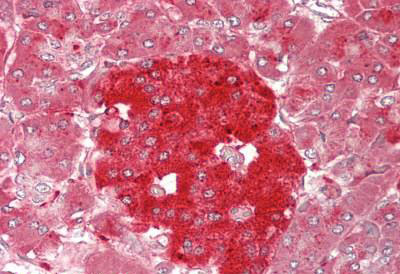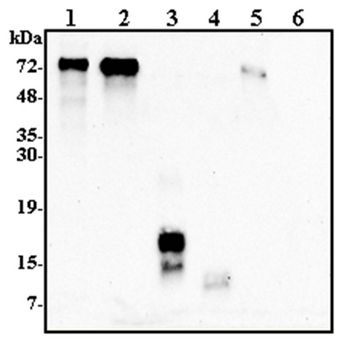GRN / Granulin Antibody
Pig Polyclonal Antibody
- SPECIFICATION
- CITATIONS
- PROTOCOLS
- BACKGROUND

Application
| WB, IHC-P, E |
|---|---|
| Primary Accession | P28799 |
| Other Accession | 2896 |
| Reactivity | Human |
| Host | Pig |
| Clonality | Polyclonal |
| Calculated MW | 63544 Da |
| Dilution | ELISA (1:2000 - 1:5000), IHC-P (10 µg/ml), WB (1:2000 - 1:5000), |
| Gene ID | 2896 |
|---|---|
| Other Names | GRN, Acrogranin, CLN11, Epithelin precursor, GEP, gp88, Granulin, Granulin-epithelin, Granulins, PC cell-derived growth factor, PCDGF, PEPI, PGRN, Proepithelin, Progranulin |
| Target/Specificity | Recognizes human progranulin. Detects a band of ~90kDa by Western blot. Weakly cross-reacts with mouse progranulin. Cross-reacts with hGRN-C and hGRN-F. |
| Reconstitution & Storage | PBS, pH 7.4, no preservatives. Long term: -20°C; Short term: +4°C; Avoid freeze-thaw cycles. |
| Precautions | GRN / Granulin Antibody is for research use only and not for use in diagnostic or therapeutic procedures. |
| Name | GRN (HGNC:4601) |
|---|---|
| Function | Secreted protein that acts as a key regulator of lysosomal function and as a growth factor involved in inflammation, wound healing and cell proliferation (PubMed:12526812, PubMed:18378771, PubMed:28073925, PubMed:28453791, PubMed:28541286). Regulates protein trafficking to lysosomes, and also the activity of lysosomal enzymes (PubMed:28453791, PubMed:28541286). Also facilitates the acidification of lysosomes, causing degradation of mature CTSD by CTSB (PubMed:28073925). In addition, functions as a wound-related growth factor that acts directly on dermal fibroblasts and endothelial cells to promote division, migration and the formation of capillary-like tubule structures (By similarity). Also promotes epithelial cell proliferation by blocking TNF-mediated neutrophil activation preventing release of oxidants and proteases (PubMed:12526812). Moreover, modulates inflammation in neurons by preserving neurons survival, axonal outgrowth and neuronal integrity (PubMed:18378771). |
| Cellular Location | Secreted. Lysosome Note=Endocytosed by SORT1 and delivred to lysosomes (PubMed:21092856, PubMed:28073925). Targeted to lysosome by PSAP via M6PR and LRP1, in both biosynthetic and endocytic pathways (PubMed:26370502, PubMed:28073925). Co-localized with GBA1 in the intracellular trafficking compartments until to lysosome (By similarity) {ECO:0000250|UniProtKB:P28798, ECO:0000269|PubMed:21092856, ECO:0000269|PubMed:26370502, ECO:0000269|PubMed:28073925} |
| Tissue Location | In myelogenous leukemic cell lines of promonocytic, promyelocytic, and proerythroid lineage, in fibroblasts, and very strongly in epithelial cell lines. Present in inflammatory cells and bone marrow. Highest levels in kidney |
| Volume | 50 µl |

Thousands of laboratories across the world have published research that depended on the performance of antibodies from Abcepta to advance their research. Check out links to articles that cite our products in major peer-reviewed journals, organized by research category.
info@abcepta.com, and receive a free "I Love Antibodies" mug.
Provided below are standard protocols that you may find useful for product applications.
Background
Granulins have possible cytokine-like activity. They may play a role in inflammation, wound repair, and tissue remodeling.
References
Bhandari V.,et al.Biochem. Biophys. Res. Commun. 188:57-63(1992).
Plowman G.D.,et al.J. Biol. Chem. 267:13073-13078(1992).
Bhandari V.,et al.Proc. Natl. Acad. Sci. U.S.A. 89:1715-1719(1992).
Lu R.,et al.Submitted (JUN-2002) to the EMBL/GenBank/DDBJ databases.
Yu W.,et al.Submitted (MAR-1998) to the EMBL/GenBank/DDBJ databases.
If you have used an Abcepta product and would like to share how it has performed, please click on the "Submit Review" button and provide the requested information. Our staff will examine and post your review and contact you if needed.
If you have any additional inquiries please email technical services at tech@abcepta.com.













 Foundational characteristics of cancer include proliferation, angiogenesis, migration, evasion of apoptosis, and cellular immortality. Find key markers for these cellular processes and antibodies to detect them.
Foundational characteristics of cancer include proliferation, angiogenesis, migration, evasion of apoptosis, and cellular immortality. Find key markers for these cellular processes and antibodies to detect them. The SUMOplot™ Analysis Program predicts and scores sumoylation sites in your protein. SUMOylation is a post-translational modification involved in various cellular processes, such as nuclear-cytosolic transport, transcriptional regulation, apoptosis, protein stability, response to stress, and progression through the cell cycle.
The SUMOplot™ Analysis Program predicts and scores sumoylation sites in your protein. SUMOylation is a post-translational modification involved in various cellular processes, such as nuclear-cytosolic transport, transcriptional regulation, apoptosis, protein stability, response to stress, and progression through the cell cycle. The Autophagy Receptor Motif Plotter predicts and scores autophagy receptor binding sites in your protein. Identifying proteins connected to this pathway is critical to understanding the role of autophagy in physiological as well as pathological processes such as development, differentiation, neurodegenerative diseases, stress, infection, and cancer.
The Autophagy Receptor Motif Plotter predicts and scores autophagy receptor binding sites in your protein. Identifying proteins connected to this pathway is critical to understanding the role of autophagy in physiological as well as pathological processes such as development, differentiation, neurodegenerative diseases, stress, infection, and cancer.



